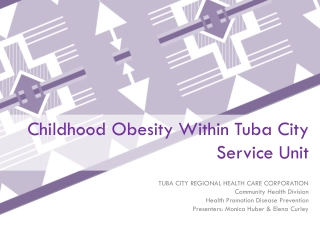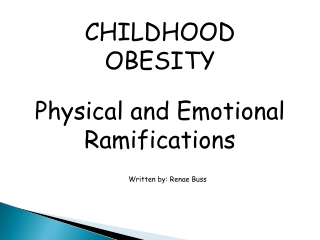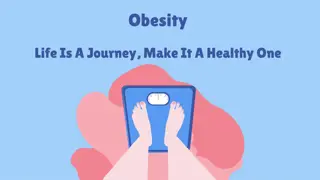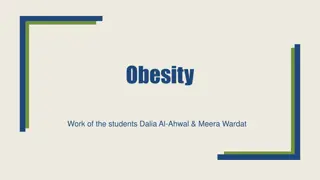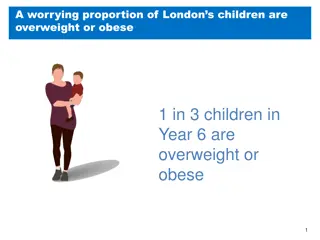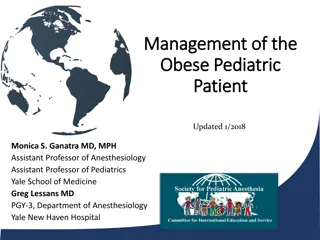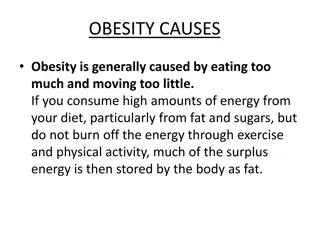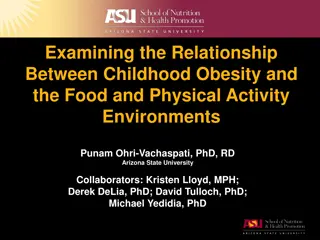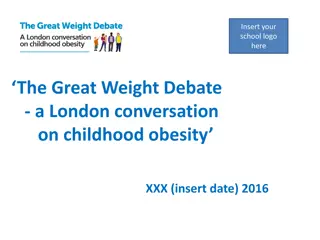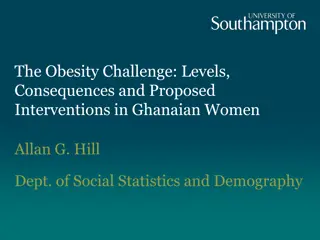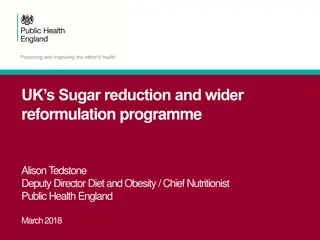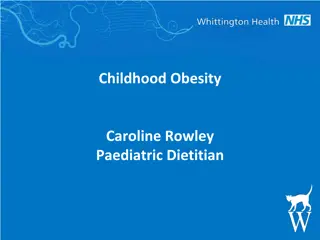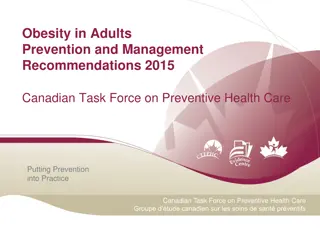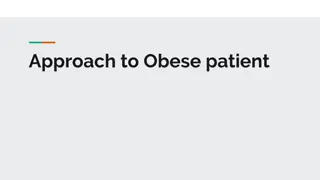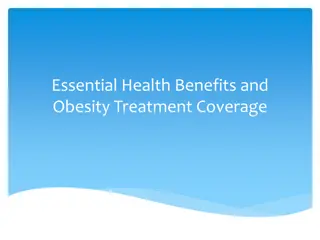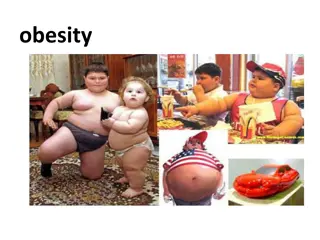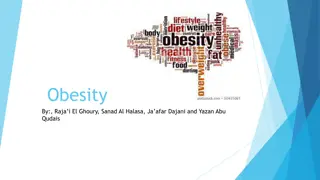Strategies for Addressing Childhood Obesity in Canadian Children
This content delves into the prevalence of overweight and obesity in Canadian children, comorbidities associated with these conditions, impacts in adulthood, and challenges in adherence to care standards. It also discusses practical intervention guidelines focused on lifestyle modifications and motivational interviewing techniques in the primary care setting to address childhood obesity effectively.
- Childhood obesity
- Canadian children
- Intervention strategies
- Lifestyle modifications
- Motivational interviewing.
Download Presentation

Please find below an Image/Link to download the presentation.
The content on the website is provided AS IS for your information and personal use only. It may not be sold, licensed, or shared on other websites without obtaining consent from the author. Download presentation by click this link. If you encounter any issues during the download, it is possible that the publisher has removed the file from their server.
E N D
Presentation Transcript
Jrmie Marcoux Vendredi 2 juin 2017
% enfants canadiens atteints de surpoid ou dobsit ? (stat can 2011, Rodd CMAJ 2016) Comorbidit s (Lambert 2008; Fennoy 2010) R percussions l ge adulte (Reilly 2011) Faible adh rence aux standards de soins (Mabry 2005, Cook 2005, Hillman 2009, Kuhle 2011;)
Guide de pratique (INESS 2012) Intervention ax e sur le mode de vie Pas de recommandation quant au type d entrevue pour y parvenir Revue syst matique 0-6 ans (Colquitt, Loveman et al. 2016)
P: 6-18 ans, embonpoint ou obsit primaire I: Entrevue visant la modification des habitudes de vie C: soins usuels, liste d attente O: mesures anthropom triques diverses (IMC, IMC-z, % adiposit ) (Millstein 2014)
Revue de la littrature sur PubMed Mai 2011-janvier 2017 Strat gie de recherche Compl t e avec d autres mots cl s de revues syst matiques (Martin, Chater et al. 2013, Colquitt, Loveman et al. 2016)
MESH utiliss Overweight, obesity, abdominal obesity, pediatric obesity, child, adolescent Population Intervention Motivational interviewing, therapy, therapeutics, interview, psychological, counseling, directive counselling, patient education as topic, health education, health behavior, health promotion, life style, healthy lifestyle, psychotherapy, psychotherapy, group psychotherapy, psychodynamic, psychotherapy, rational-emotive, psychotherapy, multiple psychotherapy, brief, cognitive therapy, behavior therapy, behavior control, social support, family therapy, acceptance and commitment therapy, reality therapy Body weight, ideal body weight, weight loss, body weight changes, body weight maintenance, waist-height-ratio, body mass index, waist circumference Issue primaire
Critres inclusion 6 18 ans Crit res exclusion tudes qui ciblent sp cifiquement les IMC>99,9ep ou IMC-z >3 Comorbidit s pouvant interf rer avec le traitement Prise de m dicaments potentiellement confondant Interventions ne pouvant tre administr es dans un contexte de soins de premi re ligne Intervention n incluant pas d entrevue en face face Intervention d velopp sp cifiquement pour un groupe culturel autre que Nord-Am ricain D finition reconnue de l embonpoint ou de l ob sit Essai clinique randomis Essai clinique contr l Essai clinique pragmatique Fran ais, anglais Mai 2011 7 janvier 2017 Pas assez d information dans l article, les annexes et le protocole pour statuer sur le respect des crit res d inclusion et d exclusion.
4 articles identifis par la recherche manuelle 2235 articles identifi s par la recherche de litt rature 2233 articles apr s retrait des duplicats et protocoles 2173 exclus par application des crit res d inclusion et d exclusion 52 exclus 2233 valu s par le titre et le r sum ge = 13 Participants de poids normal = 3 60 articles valu s par lecture du manuscrit complet Ob sit non d finie = 1 Entrevue n est pas l l ment principal de l intervention = 2 8 inclus Intervention sans entrevue individuelle en face face = 5 Intervention de groupe seulement = 6 Intervention en contexte d hospitalisation = 2 Intervention inclue AP supervis e = 2 M thode d entrevue non d finie = 3 Groupe contr le inexistant ou inad quat= 7 Autre issu primaire = 7 Pas assez d information pour statuer sur l ligibilit =1
tude (Brennan, Walkley et ge 11-19 Pays Australie Inclusion Embonpoint ou ob sit (IOTB) IMC > 85e p (OMS) Intervention individuelle al. 2013) (Cohen 2016) 6-8.5 Canada (Danielsen, Nordhus et al. 2013) 7-13 Norv ge Ob sit (IOTB) (Kong, Sussman et al. 2013) 15 ans (9-11e ann e) USA (hispanique 75%) IMC >85e p (Norman, Huang et al. 2016) 11-13 USA (83% hispanique) IMC >95e p (CDC)
tude Intervention Intensit Professionne l Psychologue Suivi Contr le n (Brennan, Walkley et al. 2013) EM 1h x1, puis TCC 16h45 17 visites 6 mois 9h00 6 visites 12 mois 9h45 13 visites 3 mois Step up/step down 8 visites 6 mois 19h 12 visites 12 mois 6 mois Liste d attente 63 (Cohen 2016) EM + TCP Nutritionniste 0 Visite initiale PRN 78 (Danielsen, Nordhus et al. 2013) (Kong, Sussman et al. 2013) FBBT Psychologue 12 mois Liste d attente 49 EM + 8 appels aux parents, mat riel crit Infirmi re M decin de famille 0 Visite initiale + Liste d attente 60 (Norman, Huang et al. 2016) SCT M decin ducateur 0 Visite initiale Visite avec ducateur Mat riel crit 106 TCC: th rapie cognitivo-comportementale. EM: entrevue motivationnelle. TCP: th rapie bas e sur la th orie du comportement planifi . FBBT: family-based behavioral therapy SCT: th rapie bas e sur la th orie socio-comportementale
Dveloppe dans les annes 80 Approche la plus tudi e (Coppock, Ridolfi et al. 2014), (Kendall 2012) 8 tudes, 437 enfants, 14-18 s ances, IMC-z 12 mois de 0,86 (Epstein, Paluch et al. 2007) Cible changement dans l alimentation et l AP des enfants et parents Habilet s comportementales
tude Interv ention EM 1h x1, puis TCC Intensit Professionnel Suivi R sultats Taillet d effet (Brennan, Walkley et al. 2013) 16h45 17 visites 6 mois Psychologue 6 mois -1,17 % pourcentage adiposit p=0.004 Petit (Cohen s d = 0.18) (Cohen 2016) EM + TCP 9h00 6 visites 12 mois Nutritionniste 0 IMC-z = non chiffr (p <0.001 12 mois) % gras = non chiffr (p=0.032 12 mois) IMC-Z = -0,16 (p=0,001) Inconnu (Danielsen, Nordhus et al. 2013) (Kong, Sussman et al. 2013) FBBT 9h45 Psychologue 12 mois Petit 13 visites 3 mois 8 visites 6 mois EM Infirmi re M decin de famille M decin ducateur 0 1. IMC perc= 0,6 (p=0,04) 2. tour de taille =-1,7 cm (p=0,04) IMC = -0.7 chez les H (p=0,003) Moyen (Cohen s d = 0,55) Moyen (Cohen s d =0,7) (Norman, Huang et al. 2016) SCT 19h 12 visites 12 mois 0
tude ge Pays Inclusion (Croker, Viner et al. 2012) 8-12 Grande - Bretagne (Blanc 57% Noir 19%) USA (Caucasien 85%) Embonpoint ou ob sit (IOTB ) (Saelens, Lozano et al. 2013) 7-11 IMC >85e p (CDC) 1 parent IMC >25 Ob sit (IOTB) (Vos, Huisman et al. 2012) 8-17 Pays-Bas
tude Intervention Intensit Professionnel Suivi Contr le n (Croker, Viner et al. 2012) FBBT 22h30 15 visites 6 mois Nutritionniste Psychologue Th rapeute familial 6 mois N=35 Liste d attente 72 (Saelens, Lozano et al. 2013) FBBT + EM 11h00 Intervenant familial 2 ans FBBT 89 20 visites 5 mois (Vos, Huisman et al. 2012) TCC 22h30 8 visites 3 mois Nutritionniste Physioth rapeute Psychologue Travailleur social 9 mois N=40 Conseils sur AP et alimentation 81
tude Intervention Intensit Suivi R sultats Taillet d effet (Croker, Viner et al. 2012) FBBT 22h30 15 visites 6 mois 6 mois IMC = -0.46 (p=0.17) 0 IMC en excluant 1 valeur aberrante = - 0.63 (p=0,03) IMC = - 0,34 (p=0,9) (Saelens, Lozano et al. 2013) FBBT + EM 11h00 20 visites 5 mois 2 ans 0 (Vos, Huisman et al. 2012) TCC 22h30 8 visites 3 mois 9 mois 3 mois IMC-z =-0.2 (p=0,05) Moyen (Cohen s d =0.59) 12 mois IMC-z -0.4 (p=0.01)
Cochrane collaboration risk of bias tool (Higgins, Altman et al. 2011) Biais de s lection Biais de performance G n ration de la s quence de randomisation personnel (Brennan, 2013) Faible Faible Haut Biais de d tection Aveuglement la mesure de l issu Faible Biais d attrition Donn es manquantes sur les issus Haut Biais de report Report s lectif Impr visibilit de la r partition Aveuglement des participants et du Faible (Cohen, 2016) (Croker et al., 2012) (Danielsen, 2013) (Kong et al., 2013) (Norman et al., 2016) (Saelens, 2013) Faible Faible Faible Faible Haut Haut Faible Faible Faible Haut Haut Faible Haut Haut Haut Haut Haut Faible Incertain Incertain Haut Incertain Haut Faible Faible Faible Haut Incertain Haut Faible Incertain Faible Faible Faible Faible Faible (Vos, 2012) Faible Haut Haut Incertain Haut Faible
Cochrane collaboration risk of bias tool (Higgins, Altman et al. 2011) Biais de s lection Biais de performance G n ration de la s quence de randomisation personnel (Brennan, 2013) Faible Faible Haut Biais de d tection Aveuglement la mesure de l issu Faible Biais d attrition Donn es manquantes sur les issus Haut Biais de report Report s lectif Impr visibilit de la r partition Aveuglement des participants et du Faible (Cohen, 2016) (Croker et al., 2012) (Danielsen, 2013) (Kong et al., 2013) (Norman et al., 2016) (Saelens, 2013) Faible Faible Faible Faible Haut Haut Faible Faible Faible Haut Haut Faible Haut Haut Haut Haut Haut Faible Incertain Incertain Haut Incertain Haut Faible Faible Faible Haut Incertain Haut Faible Incertain Faible Faible Faible Faible Faible (Vos, 2012) Faible Haut Haut Incertain Haut Faible
Cochrane collaboration risk of bias tool (Higgins, Altman et al. 2011) Biais de s lection Biais de performance G n ration de la s quence de randomisation personnel (Brennan, 2013) Faible Faible Haut Biais de d tection Aveuglement la mesure de l issu Faible Biais d attrition Donn es manquantes sur les issus Haut Biais de report Report s lectif Impr visibilit de la r partition Aveuglement des participants et du Faible (Cohen, 2016) (Croker et al., 2012) (Danielsen, 2013) (Kong et al., 2013) (Norman et al., 2016) (Saelens, 2013) Faible Faible Faible Faible Haut Haut Faible Faible Faible Haut Haut Faible Haut Haut Haut Haut Haut Faible Incertain Incertain Haut Incertain Haut Faible Faible Faible Haut Incertain Haut Faible Incertain Faible Faible Faible Faible Faible (Vos, 2012) Faible Haut Haut Incertain Haut Faible
Interventions individuelles semblent plus efficaces TCC 2 tudes/2 positives, 1 bonne qualit FBBT et EM 1 tude/2 positive chacune, faible qualit (Saelens, Lozano et al. 2013) (Croker, Viner et al. 2012) SCT, TCP 1 tude/1 positive, bonne qualit Efficacit > ?
Signification clinique Taille d effet Sans Tx, embonpoint et ob sit progressent (Cunningham, Kramer et al. 2014) Maintien Vs r duction de l embonpoint/ob sit Interpr tation des 2 r sultats n gatifs Effets ind sirables
Implication clinique Existence d interventions efficaces Intensit de Tx > offre Organisation des soins Qui peut potentiellement le plus en b n ficier ?
Prvalence de lembonpoint et de lobsit Interventions tudi es et efficaces Agir t t Organisation des soins
Abraham, A. A., Chow, W. C., So, H. K., Yip, B. H., Li, A. M., Kumta, S. M., . . . Nelson, E. A. (2015). Lifestyle intervention using an internet-based curriculum with cell phone reminders for obese Chinese teens: a randomized controlled study. PLoS One, 10(5), e0125673. doi:10.1371/journal.pone.0125673 Andre, N., & Beguier, S. (2015). Using motivational interviewing as a supplement to physical activity program in obese adolescents: a RCT study. Eat Weight Disord, 20(4), 519-523. doi:10.1007/s40519-015-0219-7 Berkowitz, R. I., Rukstalis, M. R., Bishop-Gilyard, C. T., Moore, R. H., Gehrman, C. A., Xanthopoulos, M. S., . . . Wadden, T. A. (2013). Treatment of adolescent obesity comparing self-guided and group lifestyle modification programs: a potential model for primary care. J Pediatr Psychol, 38(9), 978-986. doi:10.1093/jpepsy/jst035 Best, J. R., Goldschmidt, A. B., Mockus-Valenzuela, D. S., Stein, R. I., Epstein, L. H., & Wilfley, D. E. (2016). Shared weight and dietary changes in parent-child dyads following family-based obesity treatment. Health Psychol, 35(1), 92-95. doi:10.1037/hea0000247 Boodai, S. A., McColl, J. H., & Reilly, J. J. (2014). National Adolescent Treatment Trial for Obesity in Kuwait (NATTO): project design and results of a randomised controlled trial of a good practice approach to treatment of adolescent obesity in Kuwait. Trials, 15, 234. doi:10.1186/1745-6215-15-234 Boutelle, K. N., Zucker, N., Peterson, C. B., Rydell, S., Carlson, J., & Harnack, L. J. (2014). An intervention based on Schachter's externality theory for overweight children: the regulation of cues pilot. J Pediatr Psychol, 39(4), 405-417. doi:10.1093/jpepsy/jst142 Brennan, L., Walkley, J., Wilks, R., Fraser, S. F., & Greenway, K. (2013). Physiological and behavioural outcomes of a randomised controlled trial of a cognitive behavioural lifestyle intervention for overweight and obese adolescents. Obes Res Clin Pract, 7(1), e23-41. doi:10.1016/j.orcp.2012.02.010 Broccoli, S., Davoli, A. M., Bonvicini, L., Fabbri, A., Ferrari, E., Montagna, G., . . . Giorgi Rossi, P. (2016). Motivational Interviewing to Treat Overweight Children: 24-Month Follow-Up of a Randomized Controlled Trial. Pediatrics, 137(1). doi:10.1542/peds.2015-1979
Brown, C. (2016). The Evidence-Based Practitioner: Applying Research to Meet Client Needs (C. A. Fratantoro Ed.). Philadelphia: F.A. Davis Company. Chen, J. L., Kwan, M., Mac, A., Chin, N. C., & Liu, K. (2013). iStart smart: a primary-care based and community partnered childhood obesity management program for Chinese-American children: feasibility study. J Immigr Minor Health, 15(6), 1125-1128. doi:10.1007/s10903-013-9830-8 Cohen, T. R. e. a. (2016). A family-centered lifestyle intervention for obese six- to eight-year-old children: Results from a one-year randomized controlled trial conducted in Montreal, Canada. Can J Public Health, 107, e453-460. doi:http://dx.doi.org/10.17269/cjph.107.5470 Cole, T. J., Bellizzi, M. C., Flegal, K. M., & Dietz, W. H. (2000). Establishing a standard definition for child overweight and obesity worldwide: international survey. Bmj, 320(7244), 1240-1243. Colquitt, J. L., Loveman, E., O'Malley, C., Azevedo, L. B., Mead, E., Al-Khudairy, L., . . . Rees, K. (2016). Diet, physical activity, and behavioural interventions for the treatment of overweight or obesity in preschool children up to the age of 6 years. Cochrane Database Syst Rev, 3, Cd012105. doi:10.1002/14651858.cd012105 Coppock, J. H., Ridolfi, D. R., Hayes, J. F., St Paul, M., & Wilfley, D. E. (2014). Current approaches to the management of pediatric overweight and obesity. Curr Treat Options Cardiovasc Med, 16(11), 343. doi:10.1007/s11936-014-0343-0 Croker, H., Viner, R. M., Nicholls, D., Haroun, D., Chadwick, P., Edwards, C., . . . Wardle, J. (2012). Family-based behavioural treatment of childhood obesity in a UK National Health Service setting: randomized controlled trial. Int J Obes (Lond), 36(1), 16-26. doi:10.1038/ijo.2011.182 Danielsen, Y. S., Nordhus, I. H., Juliusson, P. B., Maehle, M., & Pallesen, S. (2013). Effect of a family-based cognitive behavioural intervention on body mass index, self-esteem and symptoms of depression in children with obesity (aged 7-13): a randomised waiting list controlled trial. Obes Res Clin Pract, 7(2), e116-e128. doi:10.1016/j.orcp.2012.06.003
Davoli, A. M., Broccoli, S., Bonvicini, L., Fabbri, A., Ferrari, E., D'Angelo, S., . . . Giorgi Rossi, P. (2013). Pediatrician-led motivational interviewing to treat overweight children: an RCT. Pediatrics, 132(5), e1236- 1246. doi:10.1542/peds.2013-1738 DeBar, L. L., Stevens, V. J., Perrin, N., Wu, P., Pearson, J., Yarborough, B. J., . . . Lynch, F. (2012). A primary care-based, multicomponent lifestyle intervention for overweight adolescent females. Pediatrics, 129(3), e611-620. doi:10.1542/peds.2011-0863 Dutton, G. R., Fontaine, K. R., Alcorn, A. S., Dawson, J., Capers, P. L., & Allison, D. B. (2015). Randomized controlled trial examining expectancy effects on the accuracy of weight measurement. Clin Obes, 5(1), 38-41. doi:10.1111/cob.12083 Epstein, L. H., Paluch, R. A., Roemmich, J. N., & Beecher, M. D. (2007). Family-based obesity treatment, then and now: twenty-five years of pediatric obesity treatment. Health Psychol, 26(4), 381-391. doi:10.1037/0278- 6133.26.4.381 Gerards, S. M., Dagnelie, P. C., Gubbels, J. S., van Buuren, S., Hamers, F. J., Jansen, M. W., . . . Kremers, S. P. (2015). The effectiveness of lifestyle triple P in the Netherlands: a randomized controlled trial. PLoS One, 10(4), e0122240. doi:10.1371/journal.pone.0122240 Gourlan, M., Sarrazin, P., & Trouilloud, D. (2013). Motivational interviewing as a way to promote physical activity in obese adolescents: a randomised-controlled trial using self-determination theory as an explanatory framework. Psychol Health, 28(11), 1265-1286. doi:10.1080/08870446.2013.800518 Hadley, W., McCullough, M. B., Rancourt, D., Barker, D., & Jelalian, E. (2015). Shaking up the system: the role of change in maternal-adolescent communication quality and adolescent weight loss. J Pediatr Psychol, 40(1), 121- 131. doi:10.1093/jpepsy/jsu073 Higgins, J. P., Altman, D. G., Gotzsche, P. C., Juni, P., Moher, D., Oxman, A. D., . . . Sterne, J. A. (2011). The Cochrane Collaboration's tool for assessing risk of bias in randomised trials. Bmj, 343, d5928. doi:10.1136/bmj.d5928
Hofsteenge, G. H., Chinapaw, M. J., Delemarre-van de Waal, H. A., & Weijs, P. J. (2014). Long-term effect of the Go4it group treatment for obese adolescents: a randomised controlled trial. Clin Nutr, 33(3), 385-391. doi:10.1016/j.clnu.2013.06.002 Hrobjartsson, A., Thomsen, A. S., Emanuelsson, F., Tendal, B., Hilden, J., Boutron, I., . . . Brorson, S. (2012). Observer bias in randomised clinical trials with binary outcomes: systematic review of trials with both blinded and non-blinded outcome assessors. Bmj, 344, e1119. doi:10.1136/bmj.e1119 INESS (2012). Traitement de l'ob sit des enfants et adolescent en 1re et 2e ligne (pp. 74). Montr al, Qu bec: Biblioth que et Archives nationales du Qu bec, 2012. Jelalian, E., Hadley, W., Sato, A., Kuhl, E., Rancourt, D., Oster, D., & Lloyd-Richardson, E. (2015). Adolescent weight control: an intervention targeting parent communication and modeling compared with minimal parental involvement. J Pediatr Psychol, 40(2), 203-213. doi:10.1093/jpepsy/jsu082 Jensen, M. E., Gibson, P. G., Collins, C. E., Hilton, J. M., & Wood, L. G. (2013). Diet-induced weight loss in obese children with asthma: a randomized controlled trial. Clin Exp Allergy, 43(7), 775-784. doi:10.1111/cea.12115 Kahan, B. C., Rehal, S., & Cro, S. (2015). Risk of selection bias in randomised trials. Trials, 16, 405. doi:10.1186/s13063-015-0920-x Kendall, P. C. (2012). Child and adolescent therapy, cognitive-behavioral procedures, 4th edition: The Guilford Press. Kim, H. S., Park, J., Park, K. Y., Lee, M. N., & Ham, O. K. (2016). Parent Involvement Intervention in Developing Weight Management Skills for both Parents and Overweight/Obese Children. Asian Nurs Res (Korean Soc Nurs Sci), 10(1), 11-17. doi:10.1016/j.anr.2015.07.006 Kong, A. S., Sussman, A. L., Yahne, C., Skipper, B. J., Burge, M. R., & Davis, S. M. (2013). School-based health center intervention improves body mass index in overweight and obese adolescents. J Obes, 2013, 575016. doi:10.1155/2013/575016
Kuczmarski, R. J., Ogden, C. L., Guo, S. S., Grummer-Strawn, L. M., Flegal, K. M., Mei, Z., . . . Johnson, C. L. (2002). 2000 CDC Growth Charts for the United States: methods and development. Vital Health Stat 11(246), 1- 190 Liberati, A., Altman, D. G., Tetzlaff, J., Mulrow, C., Gotzsche, P. C., Ioannidis, J. P., . . . Moher, D. (2009). The PRISMA statement for reporting systematic reviews and meta-analyses of studies that evaluate healthcare interventions: explanation and elaboration. Bmj, 339, b2700. doi:10.1136/bmj.b2700 Liu-Seifert, H., Zhang, S., D'Souza, D., & Skljarevski, V. (2010). A closer look at the baseline-observation-carried- forward (BOCF). Patient Prefer Adherence, 4, 11-16. Looney, S. M., & Raynor, H. A. (2014). Examining the effect of three low-intensity pediatric obesity interventions: a pilot randomized controlled trial. Clin Pediatr (Phila), 53(14), 1367-1374. doi:10.1177/0009922814541803 Macdonell, K., Brogan, K., Naar-King, S., Ellis, D., & Marshall, S. (2012). A pilot study of motivational interviewing targeting weight-related behaviors in overweight or obese African American adolescents. J Adolesc Health, 50(2), 201-203. doi:10.1016/j.jadohealth.2011.04.018 Markert, J., Herget, S., Petroff, D., Gausche, R., Grimm, A., Kiess, W., & Bluher, S. (2014). Telephone-based adiposity prevention for families with overweight children (T.A.F.F.-Study): one year outcome of a randomized, controlled trial. Int J Environ Res Public Health, 11(10), 10327-10344. doi:10.3390/ijerph111010327 Martin, J., Chater, A., & Lorencatto, F. (2013). Effective behaviour change techniques in the prevention and management of childhood obesity. Int J Obes (Lond), 37(10), 1287-1294. doi:10.1038/ijo.2013.107 Mayer, D. (2004). Essential Evidence-Based Medicine. Cambridge: Cambridge University Press.
Mazzeo, S. E., Kelly, N. R., Stern, M., Gow, R. W., Cotter, E. W., Thornton, L. M., . . . Bulik, C. M. (2014). Parent skills training to enhance weight loss in overweight children: evaluation of NOURISH. Eat Behav, 15(2), 225-229. doi:10.1016/j.eatbeh.2014.01.010 McCambridge, J., Sorhaindo, A., Quirk, A., & Nanchahal, K. (2014). Patient preferences and performance bias in a weight loss trial with a usual care arm. Patient Educ Couns, 95(2), 243-247. doi:10.1016/j.pec.2014.01.003 Millstein, R. A. (2014). Measuring outcomes in adult weight loss studies that include diet and physical activity: a systematic review. J Nutr Metab, 2014, 421423. doi:10.1155/2014/421423 Moens, E., & Braet, C. (2012). Training parents of overweight children in parenting skills: a 12-month evaluation. Behav Cogn Psychother, 40(1), 1-18. doi:10.1017/s1352465811000403 Norman, G., Huang, J., Davila, E. P., Kolodziejczyk, J. K., Carlson, J., Covin, J. R., . . . Patrick, K. (2016). Outcomes of a 1-year randomized controlled trial to evaluate a behavioral 'stepped-down' weight loss intervention for adolescent patients with obesity. Pediatr Obes, 11(1), 18-25. doi:10.1111/ijpo.12013 Pakpour, A. H., Gellert, P., Dombrowski, S. U., & Fridlund, B. (2015). Motivational interviewing with parents for obesity: an RCT. Pediatrics, 135(3), e644-652. doi:10.1542/peds.2014-1987 Parra-Medina, D., Mojica, C., Liang, Y., Ouyang, Y., Ramos, A. I., & Gomez, I. (2015). Promoting Weight Maintenance among Overweight and Obese Hispanic Children in a Rural Practice. Child Obes, 11(4), 355-363. doi:10.1089/chi.2014.0120 Pbert, L., Druker, S., Gapinski, M. A., Gellar, L., Magner, R., Reed, G., . . . Osganian, S. (2013). A school nurse- delivered intervention for overweight and obese adolescents. J Sch Health, 83(3), 182-193. doi:10.1111/josh.12014 Raynor, H. A., Osterholt, K. M., Hart, C. N., Jelalian, E., Vivier, P., & Wing, R. R. (2012). Efficacy of U.S. paediatric obesity primary care guidelines: two randomized trials. Pediatr Obes, 7(1), 28-38. doi:10.1111/j.2047- 6310.2011.00005.x
Resnicow, K., McMaster, F., Bocian, A., Harris, D., Zhou, Y., Snetselaar, L., . . . Wasserman, R. C. (2015). Motivational interviewing and dietary counseling for obesity in primary care: an RCT. Pediatrics, 135(4), 649-657. doi:10.1542/peds.2014-1880 Robertson, W., Fleming, J., Kamal, A., Hamborg, T., Khan, K. A., Griffiths, F., . . . Thorogood, M. (2016). Randomised controlled trial and economic evaluation of the 'Families for Health' programme to reduce obesity in children. Arch Dis Child. doi:10.1136/archdischild-2016-311514 Saelens, B. E., Lozano, P., & Scholz, K. (2013). A randomized clinical trial comparing delivery of behavioral pediatric obesity treatment using standard and enhanced motivational approaches. J Pediatr Psychol, 38(9), 954- 964. doi:10.1093/jpepsy/jst054 Schaefer, A., Winkel, K., Finne, E., Kolip, P., & Reinehr, T. (2011). An effective lifestyle intervention in overweight children: one-year follow-up after the randomized controlled trial on "Obeldicks light". Clin Nutr, 30(5), 629-633. doi:10.1016/j.clnu.2011.03.012 Small, L., Bonds-McClain, D., Melnyk, B., Vaughan, L., & Gannon, A. M. (2014). The preliminary effects of a primary care-based randomized treatment trial with overweight and obese young children and their parents. J Pediatr Health Care, 28(3), 198-207. doi:10.1016/j.pedhc.2013.01.003 Stovitz, S. D., Berge, J. M., Wetzsteon, R. J., Sherwood, N. E., Hannan, P. J., & Himes, J. H. (2014). Stage 1 treatment of pediatric overweight and obesity: a pilot and feasibility randomized controlled trial. Child Obes, 10(1), 50-57. doi:10.1089/chi.2013.0107 Taylor, R. W., Cox, A., Knight, L., Brown, D. A., Meredith-Jones, K., Haszard, J. J., . . . Williams, S. M. (2015). A Tailored Family-Based Obesity Intervention: A Randomized Trial. Pediatrics, 136(2), 281-289. doi:10.1542/peds.2015-0595
Vos, R. C., Huisman, S. D., Houdijk, E. C., Pijl, H., & Wit, J. M. (2012). The effect of family-based multidisciplinary cognitive behavioral treatment on health-related quality of life in childhood obesity. Qual Life Res, 21(9), 1587-1594. doi:10.1007/s11136-011-0079-1 Walpole, B., Dettmer, E., Morrongiello, B. A., McCrindle, B. W., & Hamilton, J. (2013). Motivational interviewing to enhance self-efficacy and promote weight loss in overweight and obese adolescents: a randomized controlled trial. J Pediatr Psychol, 38(9), 944-953. doi:10.1093/jpepsy/jst023 Whitlock, E. P., O'Connor, E. A., Williams, S. B., Beil, T. L., & Lutz, K. W. (2010). Effectiveness of weight management interventions in children: a targeted systematic review for the USPSTF. Pediatrics, 125(2), e396-418. doi:10.1542/peds.2009-1955 Wilfley, D. E., Stein, R. I., Saelens, B. E., Mockus, D. S., Matt, G. E., Hayden-Wade, H. A., . . . Epstein, L. H. (2007). Efficacy of maintenance treatment approaches for childhood overweight: a randomized controlled trial. Jama, 298(14), 1661-1673. doi:10.1001/jama.298.14.1661 Wilson, D. K., Kitzman-Ulrich, H., Resnicow, K., Van Horn, M. L., St George, S. M., Siceloff, E. R., . . . Prinz, R. (2015). An overview of the Families Improving Together (FIT) for weight loss randomized controlled trial in African American families. Contemp Clin Trials, 42, 145-157. doi:10.1016/j.cct.2015.03.009


